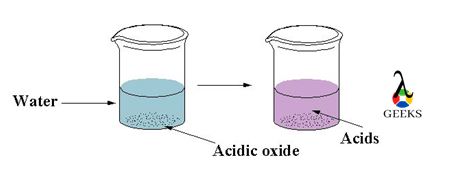Oxides formed with the reaction of metal atoms with oxygen atom. Here, at this juncture, we are learning about acidic oxide example and some facts about it. When oxide gets reacted with water it gives acid and known as acidic oxides. Also oxides can behaves as neither acid nor bas and remain as a neutral.
- CO2 + H2O → H2CO3
- SiO2 + 2H2O → Si(OH)4
- P4O6 + 6 H2O → 4 H3PO3
- P4O10 + 6 H2O → 4 H3PO4
- P2O3 + 3H2O → 2H3PO3
- P2O5 + 3H2O → 2H3PO4
- SO2 + H2O → H2SO3
- SO3 + H2O → H2SO4
- Cl2O +H2O ↔ 2HOCl
- Cl2O7 + H2O → 2 HClO4
- CrO3 + H2O → H2CrO4
- N2O5 + 3H2O → 2HNO3
- B2O3 + 3H2O → 2H3BO3
- 2NO2 + H2O → HNO3 + HNO2
- Cr2O3 + H2O → H2Cr2O4
- Mn2O7 + H2O → 2 HMnO4
- 3NO2 + H2O → 2HNO3 + NO
- N2O3 +H2O → 2HNO2
- N2O5 + H2O → 2HNO3
- SeO2 + H2O → H2SeO3
Acidic oxide Example is listed as follows:
The acidic oxides formed especially with the non- metals elements and oxygen. The non- metal elements of group 14 to 17 can from acid oxides and this is the form of acid anhydrides which form acid and water. Acid oxides and also known to be acidic anhydrides. The non- metal elements and oxygen atom have a covalent bond between them.
Mostly acid anhydrides have low boiling point and melting points except the oxides like boron oxide (B2O3) and silicon oxide (SiO2) as they have high boiling point and melting point and can form giant compounds. Most of the oxides which are covalent are highly acidic cation which exhibits acidic properties.
CO2 + H2O → H2CO3
When Carbon dioxide reacts with water it gives carbonic acid. Here, carbon dioxide (CO2) is the acidic oxide example.
SiO2 + 2H2O → Si(OH)4
When silicon oxide reacts with eater it produces ortho silicic acid. Here, silicon dioxide (SiO2) is the acidic oxide example.
P4O6 + 6 H2O → 4 H3PO3
When phosphorous trioxide reacts with water, it produced phosphorous acid. Here, phosphorous trioxide (P4O6) is the acidic oxide example.
P4O10 + 6 H2O → 4 H3PO4
When phosphorous pentaoxide reacts with water it gives phosphoric acid. Here, phosphorous pentaoxide (P4O10) is the acidic oxide example.
P2O3 + 3H2O → 2H3PO3
When di- phosphorous trioxide reacts with water, it gives phosphorous acid. Here, di- phosphorous trioxide (P2O3) is the acidic oxide example.
P2O5 + 3H2O → 2H3PO4
When di- phosphorous pentaoxide reacts with water it gives phosphoric acid. Here, di- phosphorous pentaoxide (P2O5) is the acidic oxide example.
SO2 + H2O → H2SO3
When sulphur dioxide reacts with water it produced sulphurous acid. Here, sulphur dioxide (SO2) is the acidic oxide example.
SO3 + H2O → H2SO4
When sulphur trioxide reacts with water it forms sulphuric acid. Here, sulphur trioxide (SO3) is the acidic oxide example.
Cl2O + H2O ↔ 2HOCl
When di- chlorine mono- oxide reacts with water it gives hypochlorous acid. Here, di- chlorine mono- oxide (Cl2O) is the acidic oxide example.
Cl2O7 + H2O → 2 HClO4
When chlorine heptoxide reacts with water it gives perchloric acid. Here, chlorine heptoxide (Cl2O7) is the acidic oxide example.
CrO3 + H2O → H2CrO4
When chromium trioxide reacts with water, it produces chromic acid. Here, chromium trioxide (CrO3) is the acidic oxide example.
N2O5 + 3H2O → 2HNO3
When di- nitrogen pentaoxide reacts with water it gives nitric acid. Here, di- nitrogen pentaoxide (N2O5) is the acidic oxide example.
B2O3 + 3H2O → 2H3BO3
When di- boron tri- oxide reacts with water it gives boric acid. Here, di- boron tri- oxide (B2O3) is the acidic oxide example.
2NO2 + H2O → HNO3 + HNO2
When nitrogen dioxide reacts with water it gives nitric acid and nitrous acid. Here, notrigen dioxide (NO2) is the acidic oxide example.
Cr2O3 + H2O → H2Cr2O4
When di- chromium trioxide reacts with water it gives Dihydroxy (dioxo) dichromium. Here, di- chromium trioxide (Cr2O3) is the acidic oxide example.
Mn2O7 + H2O → 2 HMnO4
When tri- oxo manganese reacts with water, it gives permanganic oxide. Here, tri- oxo manganese (Mn2O7) is the acidic oxide example.
3NO2 + H2O → 2HNO3 + NO
When nitrogen dioxide reacts with water it gives nitric acid with liberation of nitrogen mono- oxide. Here, nitrogen dioxide (NO2) is the acidic oxide example.
N2O3 + H2O → 2HNO2
When di- nitrogen tri- oxide reacts with water it gives nitrous acid. Here, di- nitrogen tri- oxide (N2O3) is the acidic oxide example.
N2O5 + H2O → 2HNO3
When di- nitrogen penta- oxide reacts with water it gives nitric acid.Here, di- nitrogen penta- oxide (N2O5) is the acidic oxide example.
SeO2 + H2O → H2SeO3
When selenium oxide reacts with water it gives selenious acid. Here, selenium oxide( SeO2) is the acidic oxide example.
Read more about Sialic Acid Structure
Some facts about acidic oxide:
When these oxides get mixed in water they produce oxo anion. Hence, the elements of oxo anion have equal oxidation number as the oxides have. When the oxides get mixed with water if they formed strong or highly strong acids then the oxides consider being soluble in water, as these acids completely ionized and the equilibrium get shifted towards dissolution.

If the oxides get mixed in water and gives moderate acidic oxoacids, thus the oxides should not be completely soluble in water. In this case, the produces oxoacid is weak acids in nature. Hence, the oxides generally soluble, but not always dissolve in water. The acidic oxides of sulphur atom (SO3) and nitrogen atom (NO2) are considered as air pollutants.
These SO3 and NO2 oxides get reacts with moisture present in atmosphere and produces the acid rain. Some oxides like ClO2 and NO2, in which the oxidation state of central atom does not matches with the oxidation state of the elements of the known or stable oxo acids. This kind of oxides by disproportionation produces a mixture of anions or oxo acids.
Conclusion:
Acidic oxides are formed with the reaction of non- metal elements and oxygen. When these acidic oxides get dissolved or miscible in water it gives acids. Non- metals of the group 14th to 17th are the participants of acidic oxides. Acidic oxides are also known as acid anhydrides. The most common acidic oxide examples are CO2, NO2, SO2, SO3, N2O5, Cl2O7, Cl2O, P2O3, P2O5, etc.

Hello everyone, I am Dr. Shruti M Ramteke, I did my Ph.D. in chemistry. I am passionate about writing and like to share my knowledge with others . Feel free to contact me on linkedin